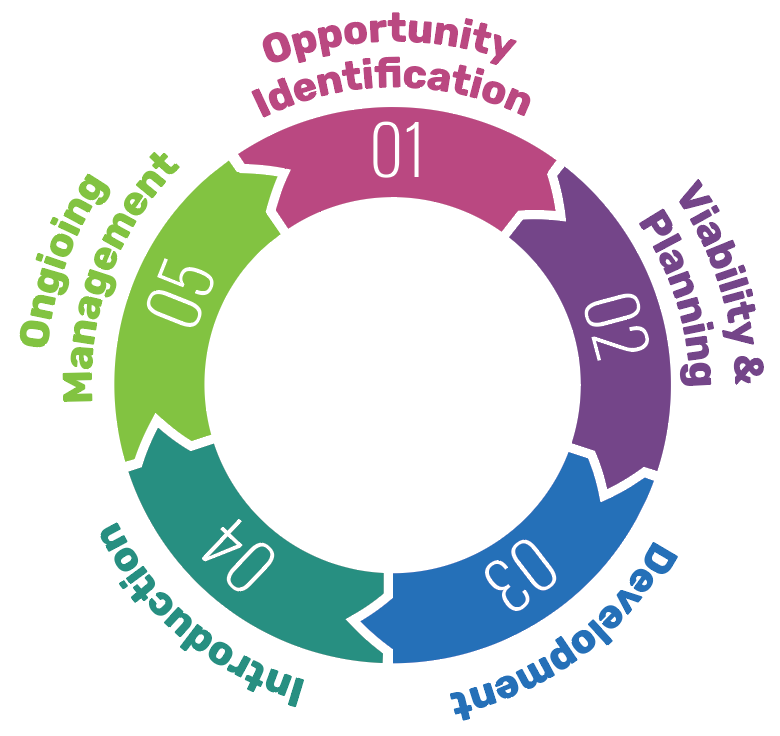Insights to Actions: The 5-Step Product Management Method
 By
Maziar Adl
·
5 minute read
By
Maziar Adl
·
5 minute read
Without Product Management, most organizations would be challenged to know where to focus their efforts. Let’s take a look at how Product Management activates an organization in the pursuit of an opportunity.
This five-step process accommodates the complexities involved in manufacturing physical goods and ensures that the product specifications are correct, viable, and shared with different functional areas to serve as the catalyst for them to do their jobs.
Here are the five distinct stages that most Product Management teams follow.
Step 1: Opportunity Identification

This step involves looking at the customer and the market. Product Managers often collaborate with team members tied to innovation or strategy. It’s a team effort to figure out what the existing or new target customer may want in order to stay or convert, with, ideally, the Product Manager at the helm. A market assessment is conducted from different angles, deploying a multitude of tools and strategies. The goal here is to define fundamental customer needs and initial product requirements that would feed into the opportunity.
Customer Knowledge
This can mean using a wide variety of assessments and insights. For instance, customer engagement studies. These can be done internally, through hiring a 3rd-party firm or consultant to conduct research with your own customers or lookalike customer segments, purchasing an existing industry report (e.g., from Forrester or Gartner), or conducting your own grass-roots research through channels such as social media, email, websites, and community forums—and of course speaking with your own internal customer-facing teams, such as Sales and Customer Support. As well as Marketing, who should have customer insights of their own, e.g., from Customer Relationship Management (CRM) tools, and organic and paid campaign reporting.
Here is also where you would typically look at your current customer experience (UEx) and what can be improved to serve the customer better and increase satisfaction with your product. Really knowing the customer and their voice involves understanding some of the metrics that matter to your organization. A few examples:
- Personas, consisting of fictional characters or profiles, which you create based on your research to represent the different customer types that might use your product in a similar way. You would use personas to create market segmentation, or subsets of a market based on demographics, needs, priorities, common interests, and other psychographic or behavioral data to better understand your target customer.
- Customer Lifetime Value (LTV), which calculates what a customer is worth to your organization over their stay with you. A typical way to calculate it is the average order total X the average number of purchases in a year X average retention time in years.
- Economic Value to Customer (EVC), which is based on the insight that a customer will buy a product only if its value to them outweighs the value of the closest alternative.
- Value maps, which are visual tools that allow you to plan better. One type of value map, for example, allows you to study your product’s position in the market in a two-dimensional graph. “The best Value Maps are customer-centric, basing value scores on benefits instead of product features or performance.” Value maps can help Product Management and Marketing derive value scores based on more objective assessment in terms of what products deliver to customers.
Market Knowledge
Understanding the space your company and products play in could mean many things, depending on your business type, size, and stage. No matter the particulars, you’re more than likely going to be doing some core market analysis that would include these exercises:
- Product/market fit, which, according to Marc Andreessen of Andreessen Horowitz means “being in a good market with a product that can satisfy that market.” Which essentially means that you need a good understanding of how big the market for your product is, what problem exists in that market, and most importantly, whether your product solves that problem sufficiently enough where a customer will be willing to pay for it.
- Competitive analysis, which maps to insights derived from gathering research from diverse sources, such as specialty software, industry reports, social media, websites, and business intelligence. The competitive research “...should include your competitors' features, market share, pricing, marketing, differentiators, strengths, weaknesses, geography, culture and customer reviews.”
- Price analysis, which can make or break the success of your product. This is especially true if your product is somewhat commoditized, meaning, you don’t have a strong brand that can weather pricing missteps due to your loyal following (think Apple, Nike, Tesla) and you have lots of competition without significant product differentiation. Price analysis involves setting the right price for your product’s lifecycle that the market will withstand, while remaining profitable for your organization.
Step 2: Viability and Planning
This step is about the initial product plan that takes you down the product definition process. You will use every insight gathered about the target customer and map your product to Jobs-to-be-done (JTBD). This method, coined by Clayton Christensen, follows the idea that customers use a product to accomplish a specific “job” or achieve a particular outcome (also see Outcome-Driven Innovation).
The set of “jobs” for the product amounts to a comprehensive list of the customer’s fundamental needs; the needs are translated into a set of product development requirements; and the requirements are mapped to product features and options. Here is also where the team reviews the different options and opportunities presented and makes decisions on what product(s) will be developed. On top of the market and customer-centric analyses, they look at other direct outcomes for their organization, such as revenue, margin, effect on brand perception, adoption, and similar factors. All the research, analysis, and inter-departmental collaboration culminates in a product plan that effectively becomes “the bible” for the entire product management process. All the functional teams that have a stake in product planning, management, production and promotion follow the product plan.
Step 3: Product Development
This step is where the validation of the solution happens. Validation can come from internal sources, such as Finance, Engineering, etc., or external, such as focus groups. Essentially, the goal is to find out if there’s an actual opportunity to deliver the product. It’s also when you start to lock down the requirements; the product definition gets more refined. At this stage, it’s important for the team to know when products will be released as well as the state of development.
While the Product Manager is not the Project Manager (see the “Product Management vs. Project Management'' section here), they have a key stake on WHEN the product or features will be out in the market. The delivery timeline depends on many factors, but here are two major considerations:
- Complexity of your product (think laptops, with few available features and configurations vs. cars, with a massive number of features and configurations)
- The degree of change you're embarking on. E.g., incremental product improvements vs. launching a brand new product, or even creating a category.
Step 4: Product Introduction
This stage includes all the act ivities necessary to get ready for launch, plus the launch itself. Although the Product Introduction step is a team effort, Product Management is the driver and key contributor.
ivities necessary to get ready for launch, plus the launch itself. Although the Product Introduction step is a team effort, Product Management is the driver and key contributor.
Many factors go into consideration, such as local assortment planning for what will be sold in what markets and regulatory approvals for the geographical areas the product will be available; local markets would have already had input to ensure compliance.
Production planning for whether the production line can handle the proposed volume also happens here. And, importantly, so does all the team training for functional areas affected by the launch. For instance, workers on the line will need to be trained on handling any special requirements; Sales will need marketing materials and a rundown on special features, benefits and differentiation. The Product Manager will supply the key information to help the other teams make informed decisions and perform in their roles.
All this action culminates in the product launch.
Step 5: Ongoing Management 
The importance of this step cannot be underestimated. It’s easy to launch a product and then move on to other projects, as frequently happens for the busy and often under-resourced product teams. Though the post-launch activity can be some of the most crucial and insightful for the just-launched product, as well as informing the future roadmap.
Measuring the new product’s performance, capturing customer feedback, watching for any competitive moves in response to your launch, and continuing promotion all fall into this bucket. Keeping a close eye on customer feedback and the market could naturally lead you back to steps 1 through 4, with the process yielding a brand new product; being consistent and high-touch with your post-launch analysis can and does uncover new opportunities. As well as show impact from the new product, help make improvements, and end of lifecycle decisions.
When it comes to hardware products, it’s important to note that besides following the right framework, key pieces for success include the right team, the right tools, and market timing.
